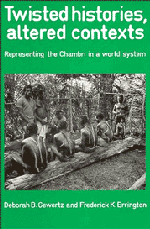Book contents
- Frontmatter
- Contents
- List of illustrations
- Acknowledgements
- Introduction: On writing the Chambri
- 1 The new traditionalism: tourism and its transformations
- 2 The initiation: making men in 1987
- 3 The town
- 4 Western representations at home
- 5 The written word
- 6 Negotiating with the state
- Conclusion: Interlocking stories, intersecting lives
- Appendix A: Godfried Kolly's life story
- Notes
- References
- Index
2 - The initiation: making men in 1987
Published online by Cambridge University Press: 05 June 2012
- Frontmatter
- Contents
- List of illustrations
- Acknowledgements
- Introduction: On writing the Chambri
- 1 The new traditionalism: tourism and its transformations
- 2 The initiation: making men in 1987
- 3 The town
- 4 Western representations at home
- 5 The written word
- 6 Negotiating with the state
- Conclusion: Interlocking stories, intersecting lives
- Appendix A: Godfried Kolly's life story
- Notes
- References
- Index
Summary
At 5:40 a.m. on October 13, 1987, Maliwan, together with his youngest son and his two wives, lay sobbing across the doorway of their house. They had spent the night before in their house singing with other members of their extended family such songs as “The brothers will lie next to each other in the ritual enclosure; we will hear them cry but will not open our eyes until they are cut.” In lying across their doorway they wished to impede members of the opposed Yambuntimeri initiatory moiety from entering. The Yambuntimeri, defined as enemies in search of war captives, were about to abduct Maliwan's five older Pombiantimeri sons and take them to the ritual enclosure where the ancestral crocodile, Kwolimopan, was waiting to “eat” the backs of these young men. The enclosure had been built of coconut fronds next to the Walindimi men's house several days before.
The Yambuntimeri prevailed, as intended, in pulling away the youths. These youths were, in fact, already marked for transition by their sisters, who had cut their brothers' hair and affixed cords around their wrists and ankles indicating the ritual restrictions to accompany, in this case, their symbolic death. By 6.30 a.m., after a half hour of intensive work, the Yambuntimeri specialists had finished making the hundreds of half-inch razor cuts on the backs and upper arms of the boys.
- Type
- Chapter
- Information
- Twisted Histories, Altered ContextsRepresenting the Chambri in the World System, pp. 58 - 100Publisher: Cambridge University PressPrint publication year: 1991



